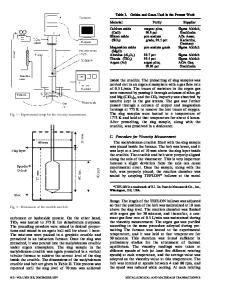Solution Chemistry in the A1 2 O 3 -Sio 2 System
- PDF / 328,085 Bytes
- 6 Pages / 420.48 x 639 pts Page_size
- 15 Downloads / 361 Views
SOLUTION CHEMISTRY IN THE A12 0 3 -SIO
2
SYSTEM
W.G. FAHRENHOLTZ*, S.L. HIETALA', D.M. SMITH%, A.J. HURD*, C.J. BRINKER", AND W.L. EARL'** UNM/NSF Center for Micro-Engineered Ceramics, University of New Mexico, Albuquerque, NM 87131 Sandia National Laboratories, P.O. Box 5800, Albuquerque, NM 87185 Los Alamos National Laboratory, Los Alamos, NM 87545
ABSTRACT In the alumina-silica system, the surface area of gels exhibit dependence upon both composition and the fluid in the pores during drying. Under controlled conditions, an anomalous drop in both the surface area and skeletal density of identically prepared gels occurs at a composition of 47% alumina. An effort has been made to understand the reasons for this phenomenon. The effect of various solution precursor systems has been investigated. Precursors that contain boehmite, or other colloidal species, do not exhibit low surface area/density at 47% alumina. Data from light scattering, infrared spectroscopy, and solution NMR will be discussed for the precursor system used to prepare low surface area gels. Data will be interpreted to determine the effect of solution structure on gel characteristics. INTRODUCTION Materials in the alumina-silica system are of general interest in ceramics due to their ubiquity as well as favorable thermal, mechanical, and electrical properties [1]. These materials also find application in heterogeneous catalysis because of chemical durability and a controlled number of active surface sites [2]. Generally, catalyst supports have been prepared by co-precipitation techniques, but more recently a great deal of effort has gone into the gel-forming of aluminosilicates [3,4]. As part of an effort to prepare A120 3-SIO 2 catalyst supports with compositions ranging from pure alumina to pure silica, it was discovered that the surface area and density of these materials was dependent upon certain washing procedures [5]. Typically, the surface area of powders was decreased by washing in water, but a large anomalous drop in both surface area and skeletal density was discovered at a composition of 47 weight percent alumina. Results from this study are detailed in Figure 1. It is thought that this effect occurs during the drying process due to the formation of closed porosity. Surface area and density have been shown to vary with the surface tension of the washing fluid, with high surface tension liquids giving low surface area powders. In order to better understand the low surface area/density phenomenon, the effect of precursor chemistry has been studied. Originally, powders were prepared by mixing a solution of TEOS/water/HCI with a saturated aluminum nitrate solution. Recently, it was shown that the same effect is possible using a TEOS/aluminum sec-butoxide/ethanol solution gelled by the addition of excess water. Solution characterization has focused on the latter precursors. Other precursors investigated include colloidal silica (Cab-o-sil) and a boehmite sol prepared by the hydrolysis of aluminum sec-butoxide (ASB) in water. Discussion in
Data Loading...











